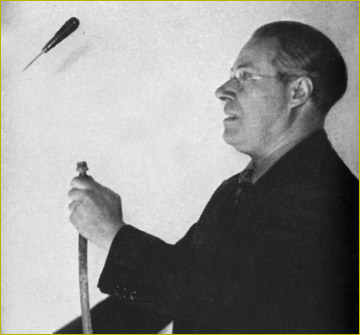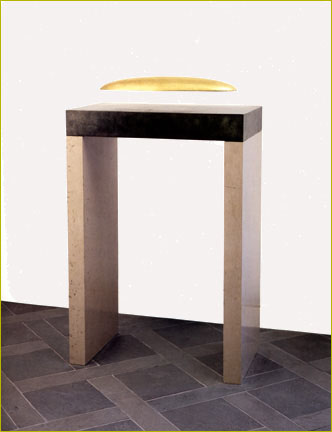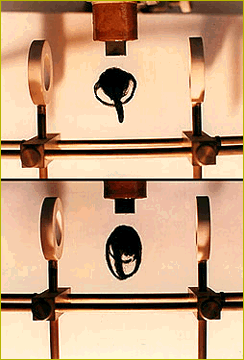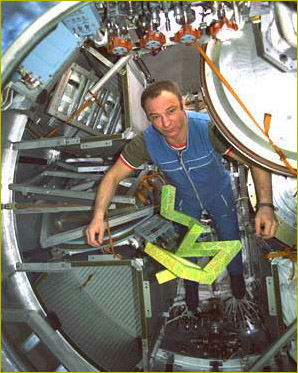|
Space Art
 Introduction
Introduction

 Against Gravitropism: Art and the Joys of Levitation
Against Gravitropism: Art and the Joys of Levitation

 Space Art Links
Space Art Links
Introduction

While there are many artworks that refer to space, few artists have
so far investigated space directly as a unique context for the creation
and installation of work. Tate in Space is attempting to redress
this as an intrinsic part of its future programme, exploring the
potential for artists residencies, sci-art collaborations and new
commissions in addition to developing imaginative and appropriate
ways in which Tate in Space may accomodate existing works from Tate's
collection.
Part of the research focuses on a practical
investigation into issues of conservation in a zero gravity,
confined and nonrenewable atmospheric environment. What happens
to a sculpture such as Richard Serra's Trip Hammer
(1988) when denied of the gravity that holds it in place?
How might this environment change the nature of works such
as Cornelia Parker's Cold Dark Matter: An Exploded View
(1991)?
|

The Great Bear, Simon Patterson © 1992
Another aspect of the research relates to cultural
concerns, in particular the question of interpretation. Issues of
context become amplified in relation to the content or appropriateness
of work sited in Space. What happens to works when they are taken
out of their original context? For instance, how might a work such
as Simon Patterson's The Great Bear (1992, see above) function
when taken out of an environment where the public transport reference
may be irrelevant and probably unknown? What might the function
of Art be in Outer Space? and who and where might be its audience?
 back to top
back to top
Against Gravitropism: Art and the Joys of
Levitation
by Eduardo Kac
In his seminal book Vision in Motion, published
posthumously in 1947, Moholy-Nagy appears levitating a chisel with
compressed air. The photograph is striking: we see Moholy-Nagy's
profile and before him the object suspended in the air with no apparent
means of support. In previous books Moholy-Nagy articulated notions
about the evolution of sculptural form, suggesting that the virtual
volume--volume created optically by the accelerated motion of an
object--was a new possibility for sculpture. As an artist crossing
many discipline boundaries, Moholy-Nagy also considered that in
the future the neutralization of gravity could be a useful tool
in design.

Moholy-Nagy levitating a chisel, as reproduced in Vision in Motion,
©1947
Although the Hungarian constructivist did not explore
this notion himself, the use of magnetism to suspend forms in space
became the key element in the innovative work of the Greek kinetic
artist Takis. In 1959 Takis introduced the aesthetic of magnetic
levitation with his elegant Télésculpture.
The piece is composed of three small conical metal pieces which
are attached, through thin wires, to three nails. The three conical
pieces are suspended above an irregular plane and levitate in front
of a magnet. This was the seed of a complex body of work through
which this magician of levitation has investigated the expressive
power of invisible forces. In September of 1959, the Moon was first
visited by the Soviet spacecraft Lunik 2. As the first probe to
impact the Moon, Lunik 2 made evident that human displacement in
space was on the horizon. Fascinated by the implications of this
idea, Takis realized an event in 1960 at the Iris Clert Gallery,
in Paris, entitled L'Impossible, Un Homme Dans L'Espace (Impossible,
A Man in Space). Donning a "Space Suit" designed by Takis, wearing
a helmet, and attached to a metal rod connected to the floor, Sinclair
Belles was "launched" across the gallery onto a safety net. Just
as Lucio Fontana's Spatialist movement made direct references to
space (in 1951 he wrote "Man's real conquest of space is his detachment
from the earth") and Yves Klein's Leap into the Void (1960)
was a photomontage alluding to the new condition of the body considered,
rather concretely, in relation to the cosmos, the event orchestrated
by Takis pointed to the unknown: the logic and the biologic that
govern human existence on Earth will not readily apply to our life
in space.

Leap into The Void, © Yves Klein (1928-1962), Silver
gelatin print 350x270mm
© ADAGP, Paris and DACS, London 2002
If Takis' work has a forceful and raw power that emanates
from his unadorned handling of materials such as iron and steel, quite
different are the levitation projects by American Thomas Shannon. Shannon
has been creating since the early 1980s a series of sculptures based on
materials such as bronze, gold, and marble, as well as painted wood, in
which the source of magnetism is not visible. Rather than seeking to make
evident the tension that results when opposite poles attract, Shannon's
sculptures search for a sense of quiet equilibrium, resting on the visual
harmony created by the presence of two basic components: the base and the
floating element. Finding in science and natural phenomena a rich source
for visual research, Shannon's vocabulary takes levitation into the realm
of a reduced articulation of sculptural forms where pairing of objects
structures the magnetic experience.

Past, Present, Future, sculpture by Tom Shannon ©1986
Many developments in twentieth-century art led to
a radical reduction in the use of physical matter to form sculptural
volume and to support this volume in space. From Gabo's constructions
(1919/20) to Fontana's perforations, from Moholy-Nagy kinetic works
to Calder's mobiles, we have witnessed a movement to liberate modern
sculpture from the constraints of enclosed and static form resting
on the two-dimensional surface of the pedestal. Artists such as
Takis and Shannon -- and the Brazilian sculptor Mario Ramiro, who
in 1986 created a self-regulating electromagnetic levitator entitled
G0 (standing for "zero gravity") -- have given continuation to this
search to release sculpture from gravitropism. [1] In Ramiro's Gravidade
Zero (Zero Gravity), an electromagnet regulated by a photo-sensor
maintains a metallic form floating in space in a state of levitation.
Freed from a two-dimensional base, and from any point of support
in space, this object is in a truly 3D kinetic space. Shown below
is a view of the electromagnet with the object surrounded by two
lenses and light source. The levitating form presents volume-inversion
relations: The area of the object's greater mass can be seen at
the top. The lower part, the traditional base of the object, does
not need to support the volume above it.

Detail of Gravidade Zero (Zero Gravity),
Mario Ramiro © 1986
The inevitable conclusion is that zero gravity is
the next frontier. Artworks have been taken aboard the Space Shuttle
since 1969, when The Moon Museum, a small ceramic tile with
drawings by artists such as Robert Rauschenberg and Andy Warhol,
was carried on Apollo 12. In 1989 Lowry Burgess flew objects on
the Shuttle as part of a conceptual artwork entitled Boundless
Cubic Lunar Aperture. However, none of these works were created
specifically to investigate the new possibilities of art in true
weightlessness. The first works to do so are the sculpture S.P.A.C.E.,
created outside the Earth by American artist Joseph McShane in 1984
and The Cosmic Dancer, by Arthur Woods, an American artist
living in Switzerland.
McShane's work was launched into space on October
5, 1984 aboard the U.S. Space Shuttle Challenger. McShane’s
piece was produced with the vacuum of space and the conditions of
zero gravity and returned to Earth in its altered state. A sphere
with a valve and earth atmosphere within was opened once in orbit.
The vacuum of space evacuated the sphere, the valve was closed,
and the vacuum of space was then contained within. For McShane,
the artwork is not the glass object per se, but the containment
of outer space within, the potential wonder generated by bringing
space vacuum to Earth and to close proximity to viewers. The question
concerning the reception of space art necessarily involves a reflection
on the experience of it in space.
The primary viewers for The Cosmic Dancer lived
with the "terrors and pleasures of levitation" in conditions
of zero gravity. A sharp-angled form launched to the Mir Space Station
on May 22, 1993, The Cosmic Dancer stressed the cultural
dimension of space since it created the experience of art integrated
into a human environment beyond Earth. The video that documents
the project shows the two Russian cosmonauts Alexander Polischuk
and Gennadi Mannakov performing (rotating, hovering, flying) with
the sculpture in the confines of Mir, where the sculpture was left.
The flaming remnants of the Mir space station plunged into the South
Pacific on 23 March, 2002.

The Cosmic Dancer sculpture on the mir space station.
Space art project by Arthur Woods launched on may 22, 1993
Arthur Woods © 1993
The Cosmic Dancer opens a new world of speculative inquiry
into the future of art in worlds other than the Earth. While we
remain confined to the blue planet, artists seeking to explore levitation
beyond magnetism and electromagnetism can investigate advanced techniques
presently only found in research laboratories. A high-temperature
electrostatic levitator allows the control of heating and levitation
independently and, unlike an electromagnetic levitator, does not
require that the floating object be a conductor of electric charge.
Acoustic levitators enable the suspension of liquids in a state
of equilibrium through acoustic radiation force. Also, liquids can
be suspended by a gas jet and stabilized by acoustic forces. Superconductor
levitators enable objects to float above a magnet in fog of liquid
nitrogen. With a laser levitator it is possible to trap gas bubbles
in water and create a condition of stable levitation by applying
optical radiation pressure of the light beam horizontally and vertically.
At last, as levitation touches biology, molecular magnetism is predicated
on the application of ordinary but very strong magnetic forces over
a regular object. The forces are directed upwards and take advantage
of the very weak magnetic response of the object present in the
field, enabling the levitation of objects usually not regarded as
capable of levitation (such as plastics) and living organisms (plants,
insects, small animals -- and conceivably humans, if the field could
be made strong enough). These techniques offer a glimpse into what
might be possible when life in the international space station becomes
more common, when colonization of the Moon goes from science fiction
to science fact, and when the space program overcomes what, in the
public opinion, is its most exciting challenge: the Mars landing.
The creation of new alloys and compounds in zero gravity and the
prospect of interplanetary colonization suggest that space exploration
is more than a metaphor in art. It is a physical and conceptual
challenge that must be met.
This text was originally published
in Kostic, Aleksandra (ed.). I Levitate, What's Next...
(Maribor, Slovenia: Kibla, 2001), pp. 88-97.
An updated version of this text can be found at http://www.ekac.org/levitation.html
1 - "Gravitropism" is a Botany term that designates
growth in response to gravity. Roots have positive gravitropism
because they grow in the same direction of gravitational forces
(i.e. down). Stems on the other hand have negative gravitropism,
as they grow against gravity (i.e. up). I use the term gravitropism
in art to underscore the fact that gravity plays a fundamental role
in the forms we are able to create on Earth, and that forms created
in zero gravity to be experienced in the same environment might
be radically different.
Eduardo Kac is an artist, writer and Associate Professor
of Art and Technology at the School of the Art Institute of Chicago
http://www.ekac.org
 back to top
back to top
Space Art Links

 Ars
Astronautica - Space Art Web Project Ars
Astronautica - Space Art Web Project

 Arthur
Woods - Cosmic Dancer on Mir Arthur
Woods - Cosmic Dancer on Mir

 Arts
Catalyst - the science-art agency Arts
Catalyst - the science-art agency

 International Association of Astronomical Artists International Association of Astronomical Artists

 KEO KEO

 Richard
Clar - Art Techologies ® Richard
Clar - Art Techologies ®

 Frank
Pietronigro: Research Project Number 33 Frank
Pietronigro: Research Project Number 33

 The
Mars Patent The
Mars Patent

 Leonardo/OLATS Leonardo/OLATS
 back to top
back to top
|



